Bootstrap Popover Template
Intro
The versions
Bootstrap is one of the most free and useful open-source platforms to develop websites. The latest version of the Bootstrap platform is known as the Bootstrap 4.
Application of the Bootstrap 4
By using Bootstrap 4 you have the ability to develop your web site now faster than ever. Additionally, it is quite very much simpler to employ Bootstrap to build your site than other types of systems. With the integration of HTML, CSS, and JS framework it is one of the absolute most leading systems for website growth.
Amazing components plus tips in Bootstrap 4
Some of the most effective features of the Bootstrap 4 feature:
• An improvised grid system that helps the user to make mobile device helpful web sites along with a fair amount of ease.
• Various utility direction sets have been included in the Bootstrap 4 to assist in easy learning for starters in the field of web design.
Items to bear in mind
Step 2: Rewrite your article by highlighting words and phrases.
With the start of the new Bootstrap 4, the connections to the earlier version, Bootstrap 3 have not been entirely removed. The programmers have made certain that the Bootstrap 3 does get periodic upgrade and fault repair along with enhancements. It will be carried out even after the ultimate launch of the Bootstrap 4.
Contrasts comparing Bootstrap 4 and Bootstrap 3
• The assistance for various web browsers including managing systems has been involved in the Bootstrap 4
• The overall sizing of the font style is improved for relaxing viewing and web site development experience
• The renaming of several elements has been completed to make sure a speedier and much more trusted website development activity
• Through new modifications, it is possible to establish a much more interactive web site along with low efforts
Bootstrap Popover Container
And now let us get to the essential theme.
In the case that you need to put in various secondary data on your internet site you have the ability to work with popovers - simply put in small overlay content.
Effective ways to utilize the popover plugin:
- Bootstrap Popover HTML rely upon the Third party library Tether for locating. You need to include tether.min.js just before bootstrap.js straight for popovers to perform!
- Popovers demand the tooltip plugin as a dependence .
- Popovers are opt-in for functioning reasons, so that you will need to activate them yourself.
- Zero-length title and content values will certainly never ever reveal a Bootstrap Popover HTML.
- Identify container:'body' to evade rendering complications in more complex factors (like Bootstrap input groups, button groups, etc).
- Triggering popovers on hidden elements will never work.
- Popovers for . disabled or disabled components need to be activated on a wrapper element. - Whenever triggered directly from website links that span multiple lines, popovers will definitely be centralized. Apply white-space: nowrap; on your <a>-s to stay away from this specific behavior.
Did you gotten the idea? Wonderful, why don't we see the way they operate by using some examples.
You will need to provide tether.min.js right before bootstrap.js in order for popovers to work!
Illustration: Set up popovers all over
One approach to initialize all popovers in a web page would be to choose them by their data-toggle attribute:
$(function ()
$('[data-toggle="popover"]').popover()
) For example: Working with the container option
If you provide some designs on a parent element which meddle with a popover, you'll prefer to define a custom-made container to make sure that the popover's HTML appears within that component as an alternative.
$(function ()
$('.example-popover').popover(
container: 'body'
)
)Static popover
Four options are available: high point, right-handed, lowest part, and left aligned.
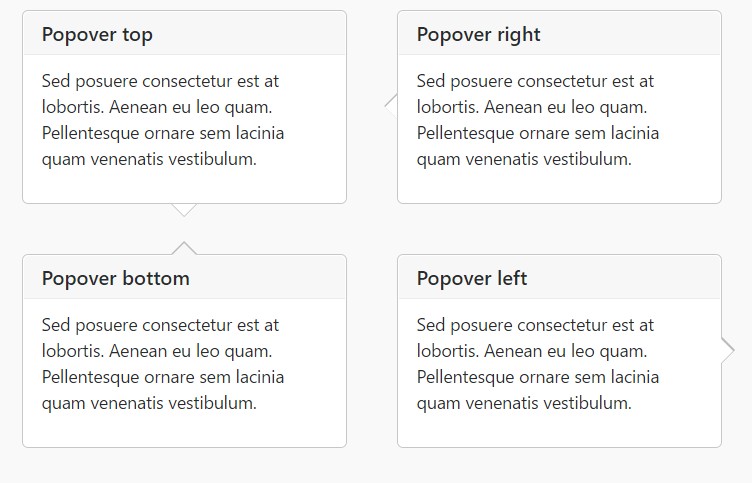
Live demo

<button type="button" class="btn btn-lg btn-danger" data-toggle="popover" title="Popover title" data-content="And here's some amazing content. It's very engaging. Right?">Click to toggle popover</button>Four ways

<button type="button" class="btn btn-secondary" data-container="body" data-toggle="popover" data-placement="top" data-content="Vivamus sagittis lacus vel augue laoreet rutrum faucibus.">
Popover on top
</button>
<button type="button" class="btn btn-secondary" data-container="body" data-toggle="popover" data-placement="right" data-content="Vivamus sagittis lacus vel augue laoreet rutrum faucibus.">
Popover on right
</button>
<button type="button" class="btn btn-secondary" data-container="body" data-toggle="popover" data-placement="bottom" data-content="Vivamus
sagittis lacus vel augue laoreet rutrum faucibus.">
Popover on bottom
</button>
<button type="button" class="btn btn-secondary" data-container="body" data-toggle="popover" data-placement="left" data-content="Vivamus sagittis lacus vel augue laoreet rutrum faucibus.">
Popover on left
</button>Dismiss upon coming mouse click
Make use of the focus trigger to force out popovers on the following hit that the site visitor makes.
Specific markup required for dismiss-on-next-click
For correct cross-browser plus cross-platform behavior, you have to employ the <a> tag, certainly not the <button> tag, and you also have to provide a tabindex attribute.

<a tabindex="0" class="btn btn-lg btn-danger" role="button" data-toggle="popover" data-trigger="focus" title="Dismissible popover" data-content="And here's some amazing content. It's very engaging. Right?">Dismissible popover</a>$('.popover-dismiss').popover(
trigger: 'focus'
)Treatment
Empower popovers with JavaScript
$('#example').popover(options)Opportunities
Selections can be successfully pass using data attributes or else JavaScript. For information attributes, add the option name to data-, as in data-animation="".
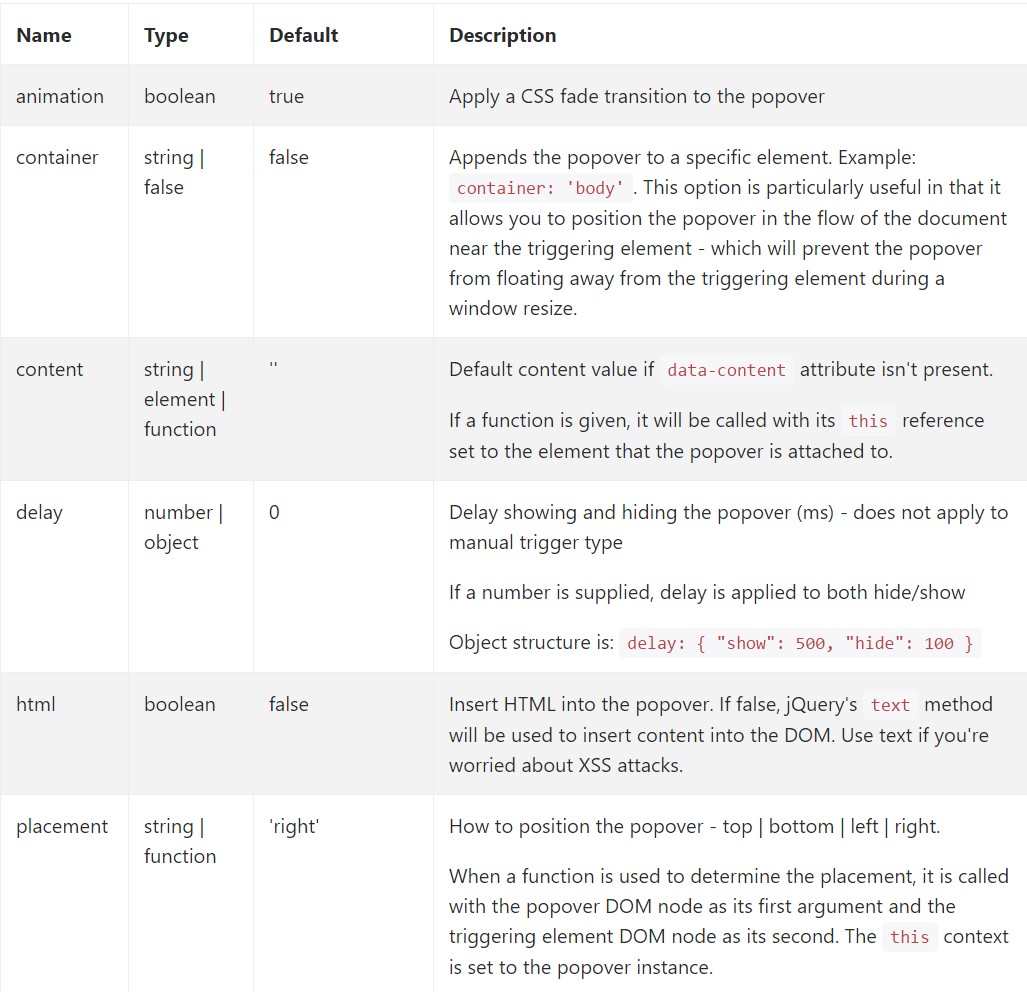
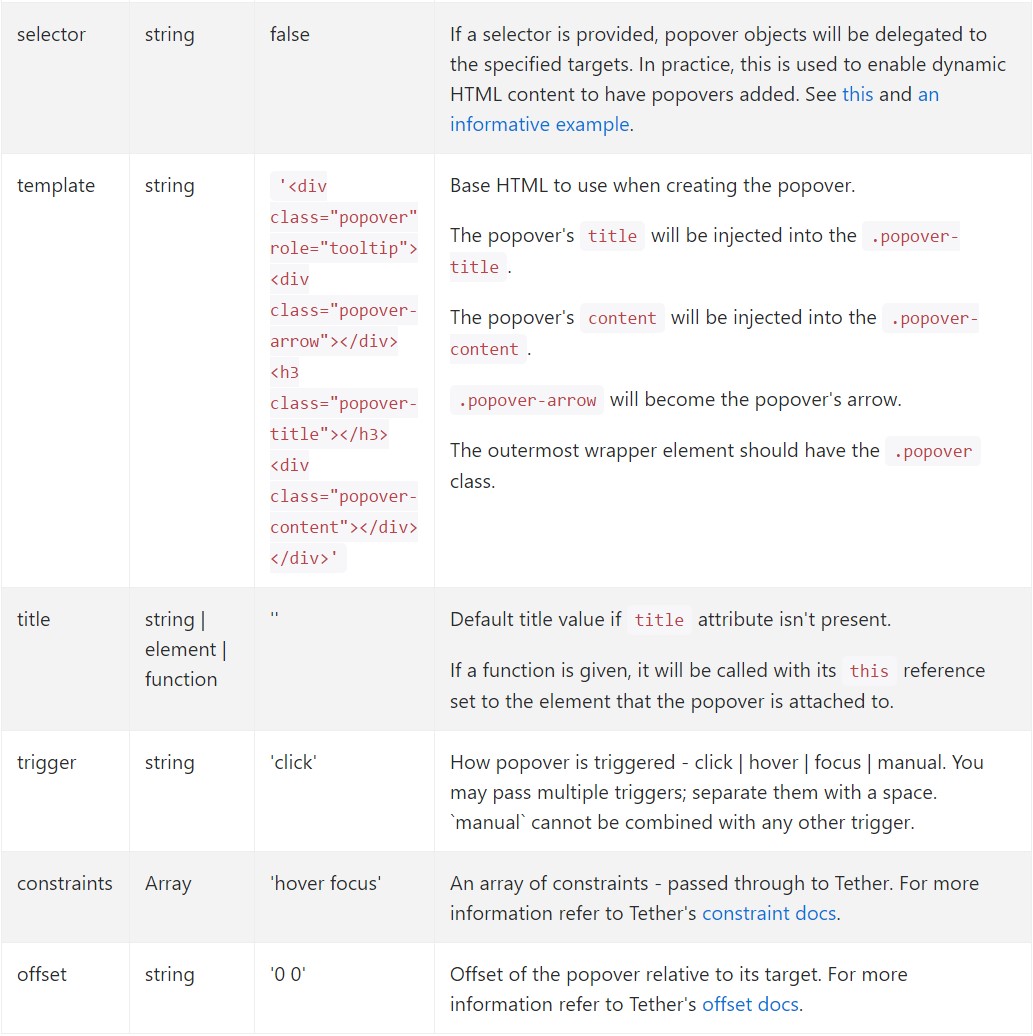
Information attributes for various popovers
Options for separate popovers may alternatively be pointed out throughout the use of data attributes, being illustrated above.
Options
$().popover(options)
Initializes popovers with regard to the element variety.
.popover('show')
Shows an element's popover. Go back to the caller before the popover has really been displayed (i.e. before the shown.bs.popover event happens). This is considered a "manual" triggering of the popover. Popovers whose both the title and material are zero-length are never displayed.
$('#element').popover('show')
.popover('hide')
Conceals an element's popover. Returns to the caller just before the popover has in fact been covered (i.e. right before the hidden.bs.popover activity occurs). This is looked at a "manual" triggering of the popover.
$('#element').popover('hide')
.popover('toggle')
Toggles an element's popover. Comes back to the caller right before the popover has truly been presented or concealed (i.e. before the shown.bs.popover or hidden.bs.popover event occurs). This is thought of a "manual" triggering of the popover.
$('#element').popover('toggle')
.popover('dispose')
Disguise and wipes out an element's popover. Popovers that work with delegation ( that are established working with the selector option) can not actually be personally eliminated on descendant trigger components.
$('#element').popover('dispose')
Events

$('#myPopover').on('hidden.bs.popover', function ()
// do something…
)
Check some on-line video short training regarding Bootstrap popovers
Related topics:
Bootstrap popovers official records
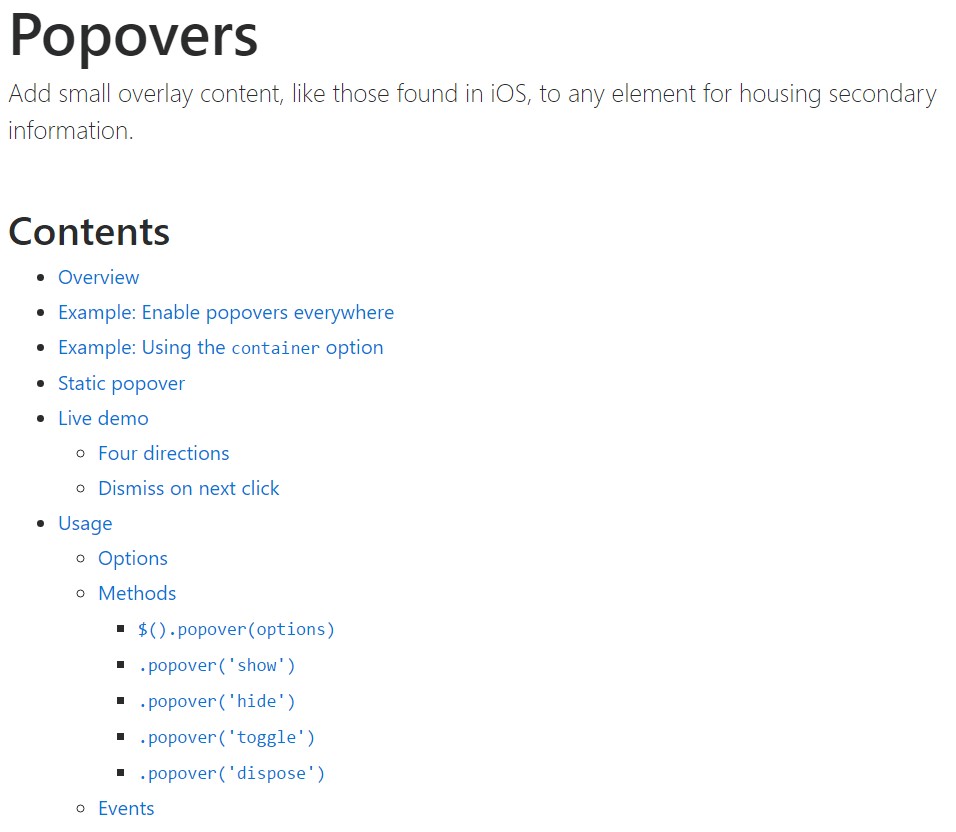
Bootstrap popovers article
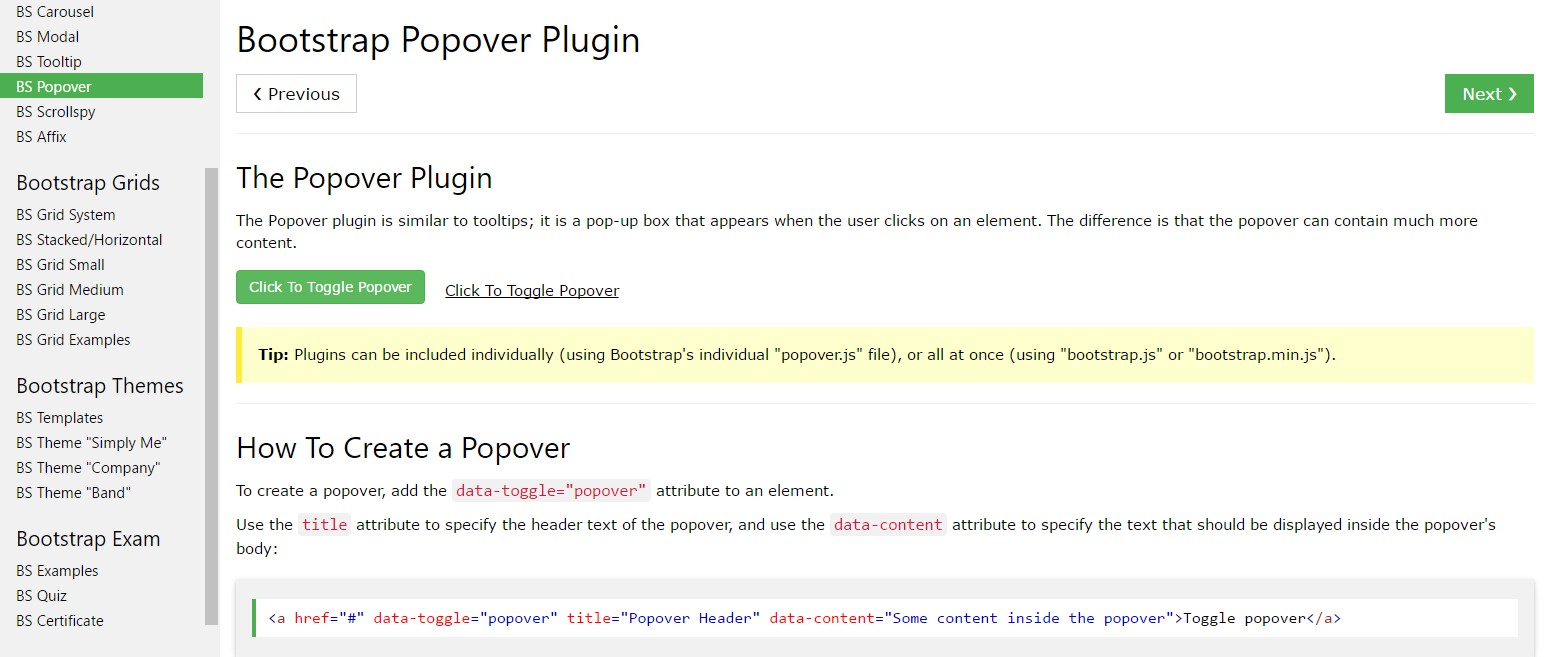
Bootstrap Popover issue
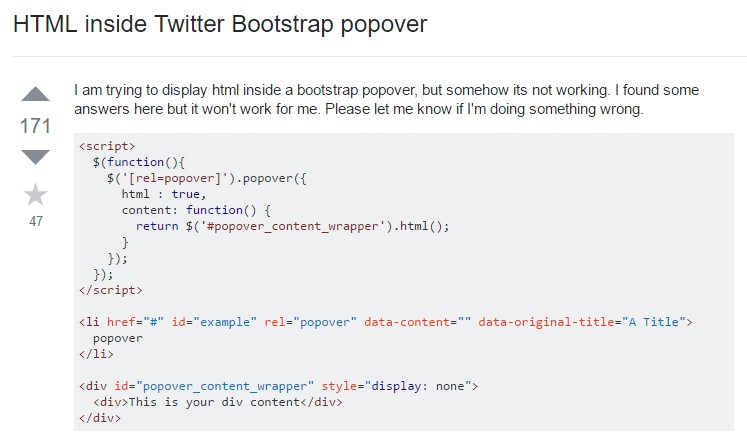
$().popover(options)
Initializes popovers with regard to the element variety.
.popover('show')
Shows an element's popover. Go back to the caller before the popover has really been displayed (i.e. before the shown.bs.popover event happens). This is considered a "manual" triggering of the popover. Popovers whose both the title and material are zero-length are never displayed.
$('#element').popover('show').popover('hide')
Conceals an element's popover. Returns to the caller just before the popover has in fact been covered (i.e. right before the hidden.bs.popover activity occurs). This is looked at a "manual" triggering of the popover.
$('#element').popover('hide').popover('toggle')
Toggles an element's popover. Comes back to the caller right before the popover has truly been presented or concealed (i.e. before the shown.bs.popover or hidden.bs.popover event occurs). This is thought of a "manual" triggering of the popover.
$('#element').popover('toggle').popover('dispose')
Disguise and wipes out an element's popover. Popovers that work with delegation ( that are established working with the selector option) can not actually be personally eliminated on descendant trigger components.
$('#element').popover('dispose')Events

$('#myPopover').on('hidden.bs.popover', function ()
// do something…
)Check some on-line video short training regarding Bootstrap popovers
Related topics:
Bootstrap popovers official records

Bootstrap popovers article

Bootstrap Popover issue
